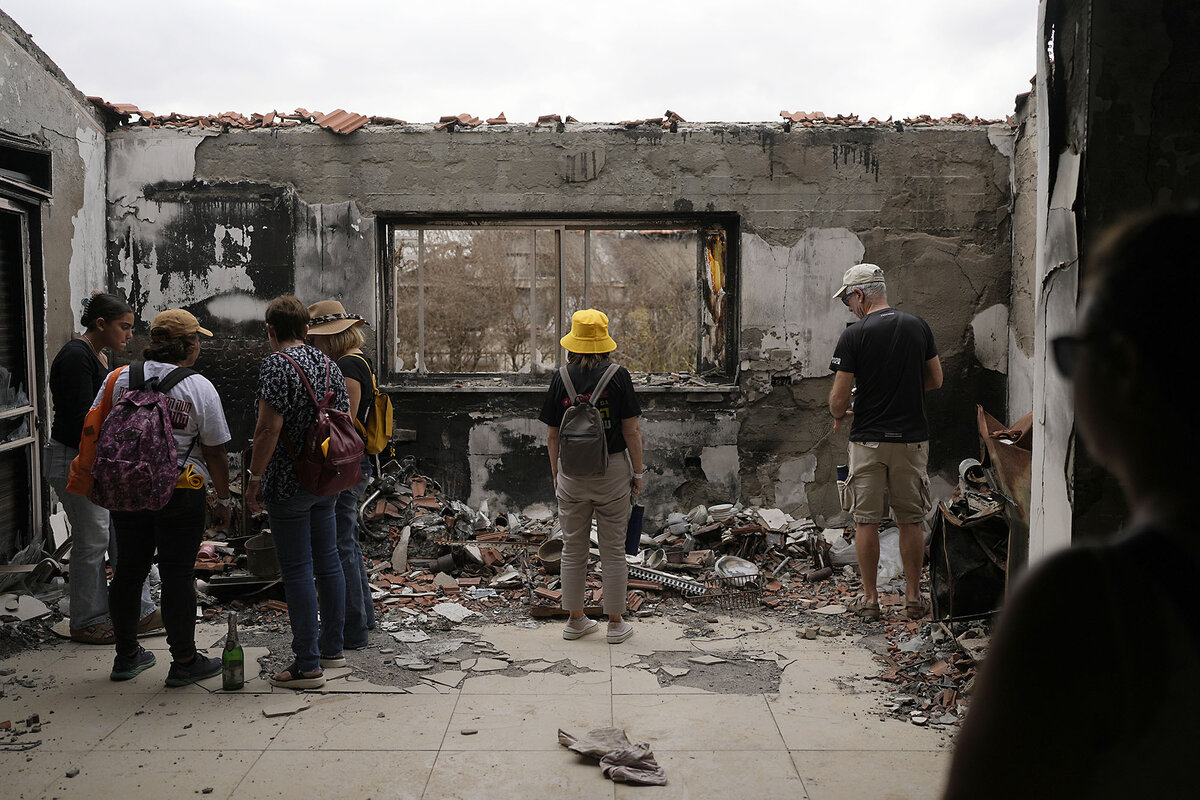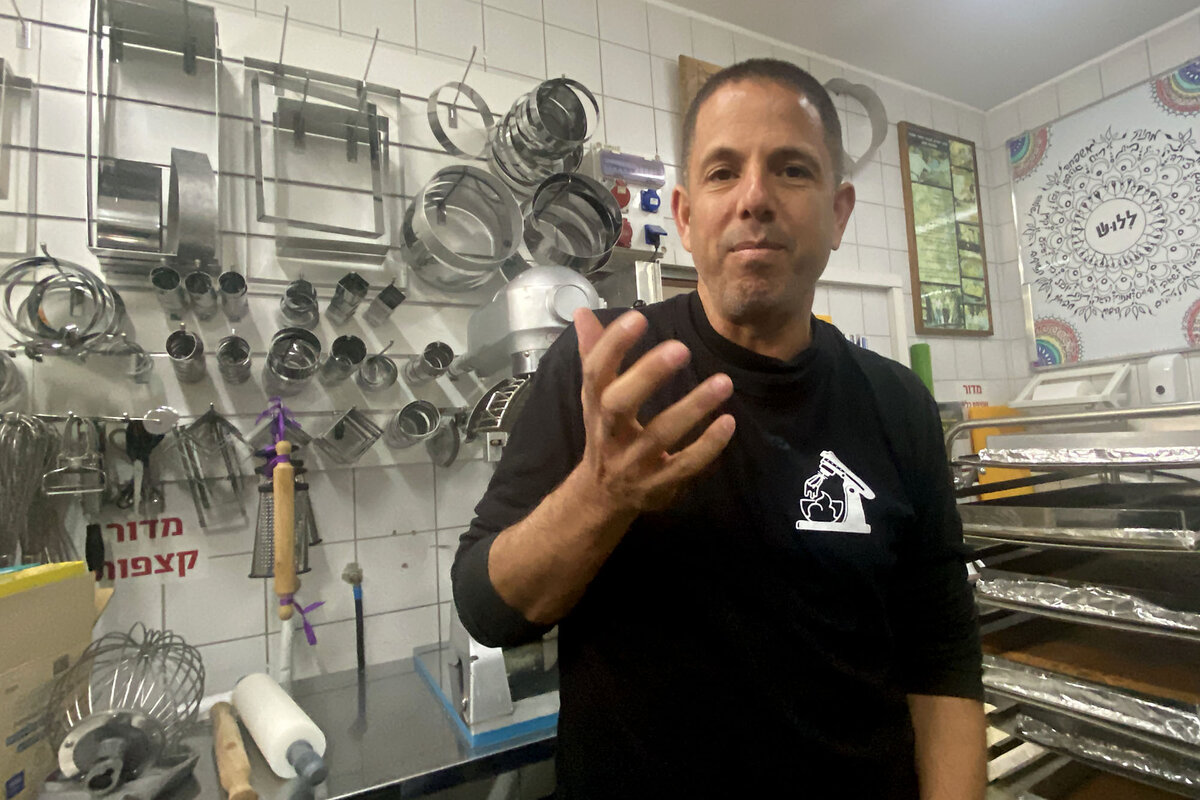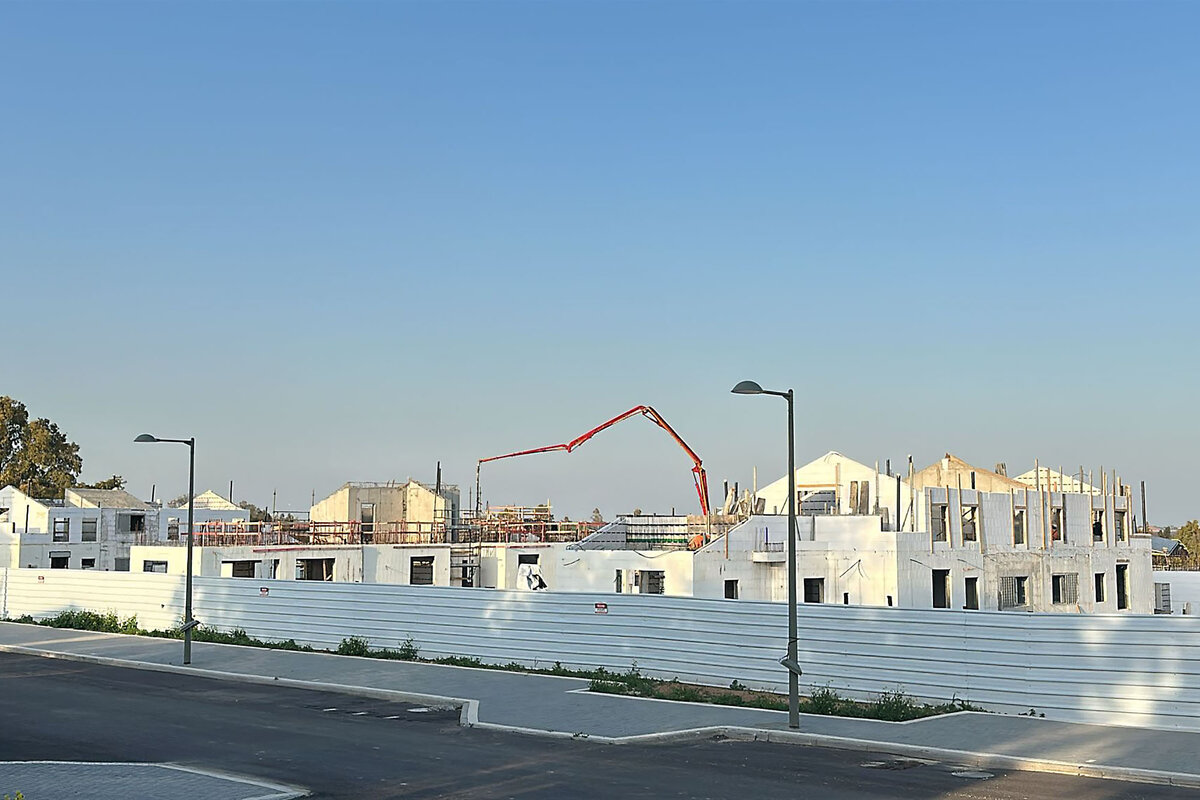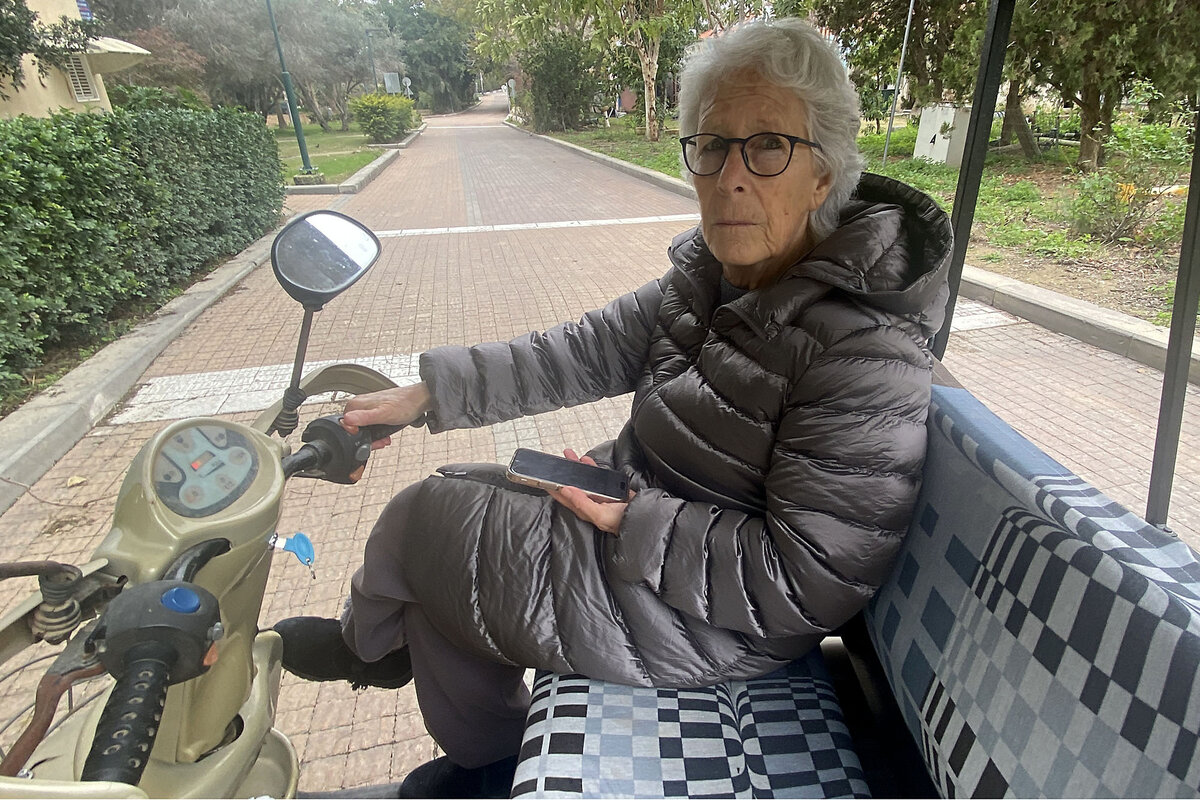Near Gaza, Israeli communities ravaged on Oct. 7 refocus on rebirth
Loading...
| Kibbutz Be’eri, Israel
Pastry chef Yaki Sagi carefully rolls a tray stacked with eight vanilla sheet cakes into place in the Lalush Bakery oven at Kibbutz Be’eri, on the border with Gaza.
By day’s end he and his assistant will make dozens more, to assemble 100 chocolate-and-cream layer cakes to be sold across Israel.
Mr. Sagi, who has the words “I am the screenwriter of my own life” tattooed on his left arm, smiles as he swirls around the kitchen under hanging baking pans and between rows of mixers and cookbooks.
Why We Wrote This
A story focused onThe kibbutzim and other Israeli communities near Gaza still bear the marks, physical and spiritual, of the horrors of Oct. 7. But as hostages, living and dead, return home, the communities are rebuilding, and shifting toward “tekuma,” rebirth.
He reopened the bakery, which operates out of a room in Be’eri’s communal dining hall, just two weeks ago, another step in the slow and steady process of rebirth for Israeli communities near the Gaza Strip.
“It’s like waking up after a year and a half; it’s really exciting,” he says. “It’s also complicated. ... Over 100 people vanished from here in one day. It’s unimaginable – like a movie, a bad movie.
“There were days I thought we would wake up from this movie, but it’s the reality and we must continue.”
Kibbutz Be’eri, a communal village surrounded by wheat fields and mango and avocado groves, became the scene of a massacre when Hamas gunmen rammed a bulldozer through its perimeter fence and began systematically shooting anyone they encountered. As kibbutz residents texted warnings frantically among themselves, the attackers fired through doors and walls with automatic weapons and RPGs, tossed grenades through windows, and set homes ablaze.
This community and others nearby became ground zero of the deadliest day in Israel’s history. Oct. 7, 2023, saw 1,200 people killed and some 250 taken hostage, triggering the devastating Israel-Hamas war in Gaza. On Kibbutz Be’eri, home to many who for years fought for peace and better ties with their Gaza neighbors, more than 100 civilians were killed – about a tenth of its population – and 32 taken hostage to Gaza, some of whom were killed there.
On nearby Kibbutz Nir Oz, Yarden and Shiri Bibas and their two redheaded young boys were among 79 people taken hostage that same morning while 46 were murdered. Yarden was released Feb. 1 under the current Israel-Hamas ceasefire deal.
On Feb. 26, an estimated 100,000 Israelis lined the roads for dozens of miles as a coffin containing Shiri and her sons was taken to Nir Oz for burial, their bodies having been returned the week before. It was an outpouring of a national grief that still hangs heavily over these communities as they try to pivot toward the future.
Getting back to work
For now, the fragile ceasefire is holding, quieting the sounds of war next door. With the last of Be’eri’s living hostages having been freed – an emaciated Eli Sharabi, who only learned upon his release that his wife and two daughters were killed Oct. 7 – the kibbutz is making headway in its plans to rebuild.
Its main source of income, a lucrative printing press, is running at full capacity, employing 400 workers. Smaller businesses like a supermarket, dairy, and the Lalush Bakery are running again, as are the communal laundry, health clinic, and dining hall to serve the workers and the 150 members who have returned to live there. Most of the others reside temporarily on Kibbutz Hatzerim, near the southern city of Beersheva, including Mr. Sagi and his family.
“My dream is to open a huge bakery,” says Mr. Sagi, beaming. Plans are underway to build one just outside the entrance of the kibbutz, alongside the dairy and a mountain biking and nature center.
“That will be the real rebirth,” he says.
Tekuma, Hebrew for “rebirth” or “renewal,” is the name of the government agency created to oversee the rebuilding of the Gaza-area communities. Most of its $423 million budget for physical reconstruction is earmarked for the three hardest-hit kibbutzim, including Be’eri.
Some of its overall budget pays for temporary housing as several of the communities, among them Be’eri, still struggle with the scope of the damage and the uncertain security situation.
Tekuma’s officials, drawing on studies that show communities are most resilient and cohesive after a disaster if they are part of the planning for rebuilding, are encouraging the 46 communities and one city they are working with to do so.
Focus on rehabilitation
Close to midnight on Oct. 8, a group of Kibbutz Be’eri leaders gathered in a room of the Dead Sea hotel where the traumatized members had just been evacuated, and drafted goals for the future.
Among them was Gal Cohen, a longtime manager at the printing press, who went out on a run at 6:30 the previous morning and was one of the first people to spot the approaching gunmen.
“We immediately recognized that if we did not reestablish Be’eri, then the Gaza border area would never recover, and the Zionist movement itself would be foiled. We also decided then that we would take care of all our members, even those who might decide not to return, and we decided to reopen Be’eri,” says Mr. Cohen.
“It was clear to me on Oct. 8 when we sat together that I would change my career focus and dedicate myself to the rehabilitation of Be’eri. It felt like my mission.”
He and the other leaders realized that restoring a sense of stability was essential.
“If people have homes and jobs they can rehabilitate more quickly; they can start to see a horizon,” he says.
Be’eri is targeting the summer of 2026 for the majority of members to return. The biggest question is whether they will feel safe enough, especially families with children.
On Feb. 17, when Israel marked 500 days since the war began, many residents returned to Be’eri for the day, packing the communal dining hall and filling it with children’s voices.
“I’m sure we will return to what we had,” says David Dahan, the dining hall manager. “I’ll do all I can to be part of that – we have such a strong community here. We have what it takes.”
“It can’t possibly have happened”
Among the many buildings destroyed by Hamas was the kibbutz art gallery. Germany has pledged almost $2 million to rebuild it. A competition is underway to choose its architects.
“You can fix a house, but how can you fix the future?” asks gallery director Sofie Mackie. She says art will be part of an answer that acknowledges the trauma of the atrocities without being trapped by it.
“Art knows how to take what is most poisonous and radioactive and transform it,” she says. “An artist can come and imagine it as something else.”
Driving a golf cart through the kibbutz neighborhoods, Nili Bar-Sinai points out key moments of the rampage in a tour of the hourslong assault. Her husband, Yoram, an architect and urban planner who designed some of Be’eri’s buildings and neighborhoods, was killed in a gun battle protecting their daughter and her family Oct. 7.
“This was the first house burned,” she says, waving her hands to an empty plot. She points out another home where a mother was killed and her daughter kidnapped.
“Because I don’t believe it happened I can tell people about it,” she says, shaking her head. “It can’t possibly have happened.”
Eventually she pulls up to a large empty lot where half-destroyed homes were bulldozed. It’s surrounded by a white metal wall on which a former kibbutz member, an artist, has painted pictures of the kibbutz fields. Just beyond the lot is a construction site where the first post-Oct. 7 neighborhood is being built.
Her gaze fixed, she says, “This is the incarnation of tekuma, of rebirth.”










